IRA Reinforces EPA to Regulate Greenhouse Gases under Clean Air Act

Dollar is dominant as euro moves below dollar and China’s currency at weakest in two years
|
In Today’s Digital Newspaper |
USDA daily export sale: 110,000 metric tons of soybeans to China during the 2022-2023 marketing year.
The euro moved below the dollar on a 0.7% drop to hit $0.9968 on Monday — and continued falling today — reflecting the worsening energy crisis, and steeper odds for an economic downturn via a now hawkish Federal Reserve. Meanwhile, business activity in Europe and Japan fell in August, according to new surveys, pointing to a sharp slowdown in global economic growth. The slump comes as the Eurozone’s private sector economy shrunk for the second consecutive month in August, led by the manufacturing and tourism and recreation sectors. Other currencies, including China's yuan and Japan's yen, also fell. The U.S. currency has rallied against every major currency, including the yen, the Swiss franc and the pound this week.
China’s currency has dropped to its weakest level against the U.S. dollar in two years and it is likely to depreciate further as the country’s central bank moves to combat a slowing economy and a deep housing downturn. More in China section.
On Sunday, Shanghai authorities decided to save power by switching off iconic lights on both sides of the Huangpu River on Monday and Tuesday. Shanghai isn’t the only place going dark: large parts of China — including Sichuan, Zhejiang, Jiangsu, and Anhui — are experiencing power shortages caused by the hottest heatwaves and the deepest drought since record-keeping began 61 years ago. The current crisis is also driven by reduced energy supply from hydropower plants in drought-stricken Sichuan. More in China section.
Russian authorities accused Ukraine of carrying out the car bombing that killed Daria Dugina, 29, an ultranationalist commentator. Ukraine denied responsibility. Meanwhile, the U.S. gov’t is urging Americans in Ukraine to leave the country immediately, warning that Russia is stepping up efforts to launch attacks on civilian infrastructure and government facilities in the coming days.
Saudi Arabia warns it may push for an oil production cut. The kingdom’s energy minister said that the OPEC+ cartel of oil producers, which it effectively leads, may seek to restrict supply amid a monthslong drop in prices. The price of crude jumped after his remarks. Oil rose to near $92 a barrel in New York. More below.
U.S. natural gas futures reached 14-year highs this week — and analysts see the rise continuing.
Important policy implications: The Inflation Reduction Act (IRA) will bolster the EPA’s defenses against future legal challenges, advocates say, reinforcing the agency’s authority to regulate greenhouse gases under the Clean Air Act following a setback from the U.S. Supreme Court this summer. Details below.
Ford Motor will lay off 3,000 employees across the U.S., Canada, and India, including white collar and contract positions, as of Sept. 1, as it cuts costs on its way to an electric vehicle future. The auto maker said it would begin notifying employees this week.
President Joe Biden will make a decision on student loans this week as a majority of Americans worry about how loan forgiveness could affect inflation.
USDA Secretary Tom Vilsack will be in Illinois today with Sen. Tammy Duckworth (D-Ill.) to make a biofuels-related announcement, most likely to announce the opening of the grant applications for renewable fuels infrastructure. We have details below.
Anthony Fauci plans to step down in December from his 35-year tenure as director of the National Institute of Allergy and Infectious Diseases. Fauci, 81, will also step down from his role of chief medical adviser to Biden, though he says he won’t fully retire.
Voters head to the polls in New York, Florida and Oklahoma today. We have some key races to watch in the Politics & Elections section.
|
MARKET FOCUS |
Equities today: Global stock markets were mixed to lower overnight. U.S. stock indexes are pointed toward slightly lower openings. Macy's, Toll Brothers, Urban Outfitters, Dick's Sporting Goods, Advance Auto Parts, Nordstrom and Intuit are among the companies reporting earnings today. Analysts are expecting a jittery market this week ahead of Fed Chair Jerome Powell’s big speech on inflation at Jackson Hole, Wyoming, on Friday. Asian shares were mostly lower Tuesday, echoing a broad sell-off on Wall Street amid speculation about another interest rate raise from the U.S. Federal Reserve. Benchmarks in Asia slid in Tokyo, Sydney, Seoul and Hong Kong, but shares were little changed in Shanghai. European indexes were mixed, rising in France and Germany while falling in Britain. In Asia, Japan -1.2%. Hong Kong -0.8%. China -0.1%. India +0.5%. In Europe, at midday, London -0.4%. Paris +0.2%. Frankfurt +0.3%.
U.S. equities yesterday: The Dow fell 643.13 points, 1.91%, at 33,063,61. The Nasdaq dropped 323.64 points, 2.55%, at 12,381.57. The S&P 500 lost 90.49 points, 2.14%, at 4,137.99.
Investors put net $11.7 billion into equity mutual funds and exchange-traded funds over the two-week period ended last Wednesday, according to Refinitiv Lipper data. That is a shift from earlier in the summer, when many investors assessed their losses from a brutal start to the year and headed for the exits. All told, they withdrew $44.1 billion from equity funds across June and July, the first consecutive months of outflows since December 2020 and January 2021. Despite the recent flows into high-growth tech stocks, value stocks have done better this year. The Russell 1000 Value index is down 7.9% in 2022, compared with a 21% decline in the Nasdaq.
Agriculture markets yesterday:
- Corn: December corn futures rose 5 3/4 cents to $6.29, the highest closing price in a week.
- Soy complex: November soybeans surged 31 1/4 cents to $14.35 1/4, the contract’s highest closing price since Aug. 12. September soymeal rose $11.80 to $460.50. September soyoil rose 87 points to 68.77 cents.
- Wheat: December SRW wheat rose 17 1/4 cents to $7.88 1/4. December HRW wheat rose 19 cents to $8.66. December spring wheat rose 13 1/2 cents to $9.00 1/2.
- Cotton: December cotton declined 187 points to 114.14 cents per pound.
- Cattle: Cattle futures rebounded to end higher after dropping initially in the wake of Friday’s bearish Cattle on Feed report. October live cattle fell 75 cents to $144.50. September feeders dipped 40 cents to $184.35.
- Hogs: October lean hogs rose 85 cents to $93.975. The next CME lean hog index is expected to fall 31 cents to $119.98.
Ag markets today: December corn futures climbed to a six-week high overnight after USDA’s weekly crop ratings fell short of expectations, while soybeans and wheat also rose. As of 7:45 a.m. ET, corn futures were trading 14 to 16 cents higher, soybeans were 7 to 10 cents higher, and wheat was 7 to 14 cents higher. Front-month crude oil futures were up well over $1, and the U.S. dollar index was down slightly.
Technical viewpoints from Jim Wyckoff:
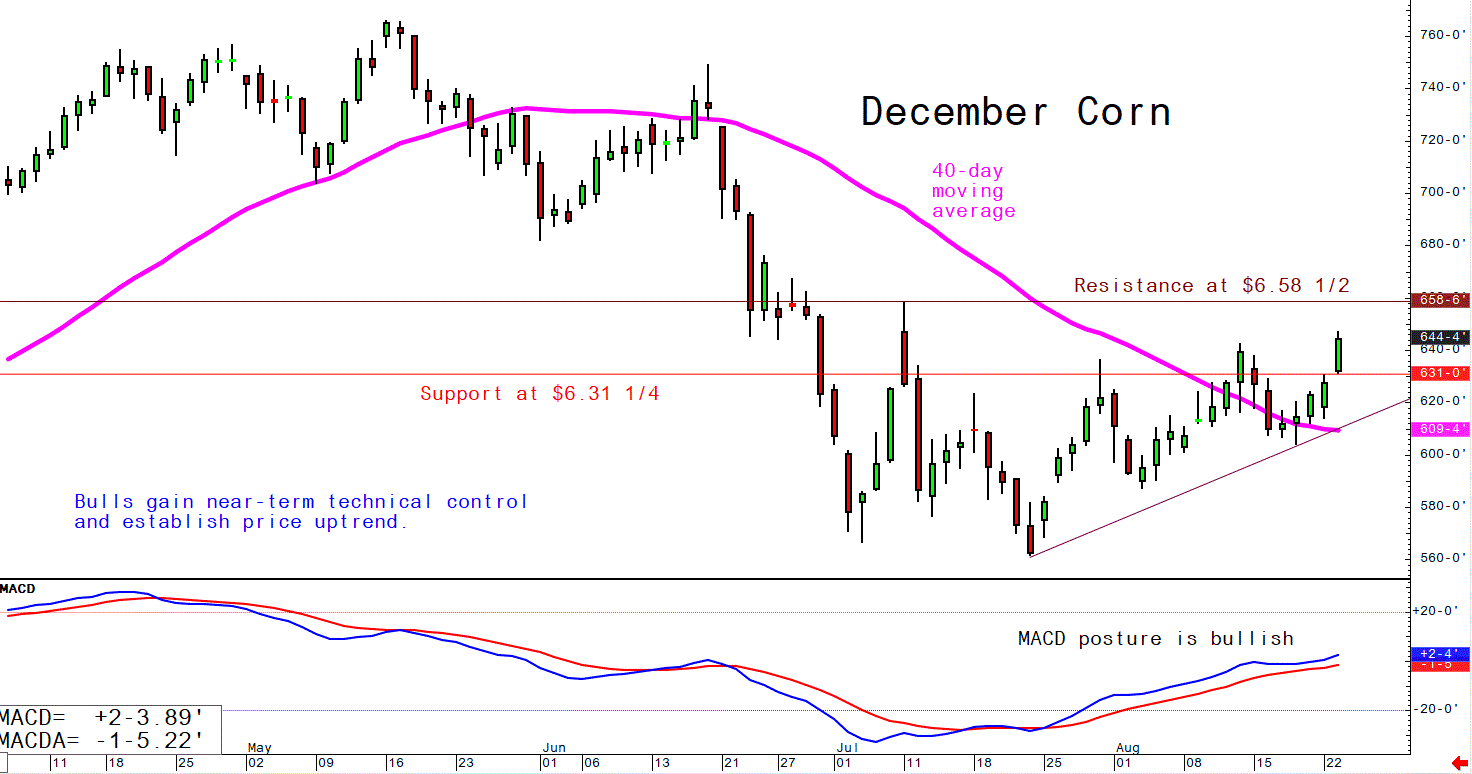



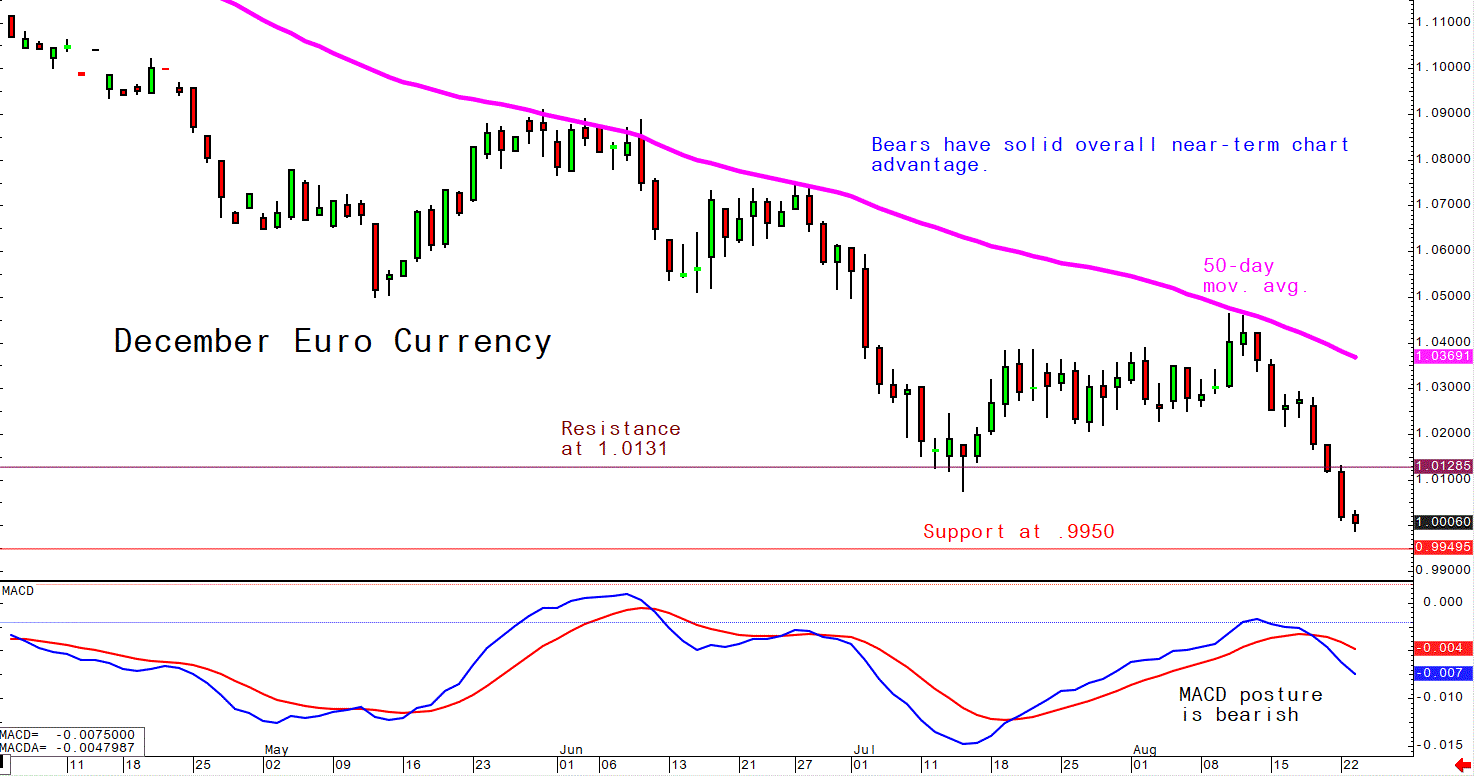
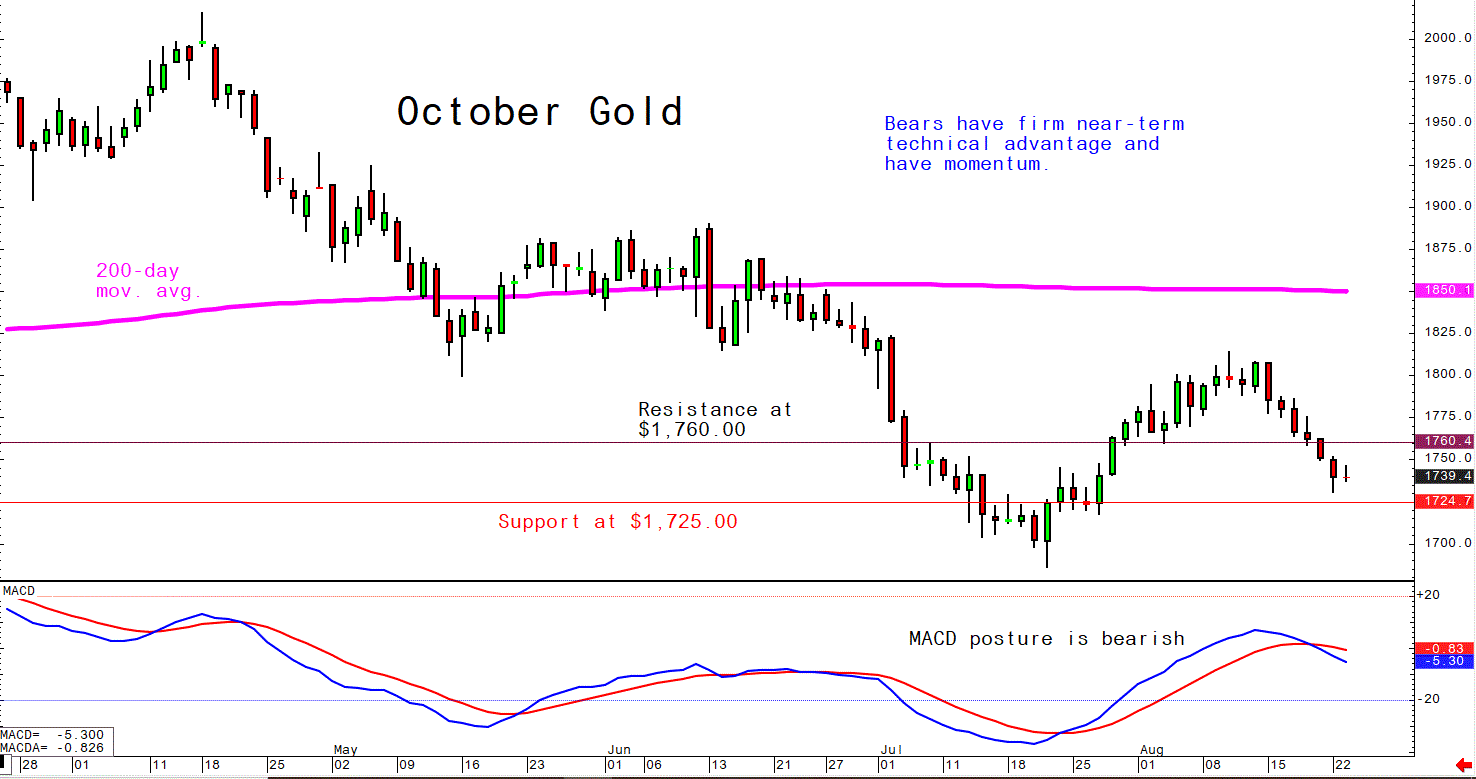
On tap today:
• S&P Global's preliminary U.S. manufacturing index for August, due at 9:45 a.m. ET, is expected to fall to 51.9 from a final July reading of 52.2. The services index is forecast to rise to 49 from 47.3.
• U.S. new home sales for July, due at 10 a.m. ET, are expected to fall to an annual pace of 574,000 in July from 590,000 one month earlier.
• Richmond Fed's manufacturing survey, due at 10 a.m. ET, is expected to fall to minus 5 in August from zero one month earlier.
• USDA Secretary Tom Vilsack will be in Illinois to make an announcement on biofuel infrastructure spending with Sen. Tammy Duckworth (D-Ill.). 11:30 a.m. ET.
• Minneapolis Fed President Neel Kashkari participates in a Q&A at the Wharton Club of Minnesota at 7 p.m. ET.
Ford axes thousands of jobs in its shift to EVs. The automaker said it was cutting 3,000 jobs, mostly in the U.S., because it needed to slash costs for its $50 billion pivot to electric vehicles. “Building this future requires changing and reshaping virtually all aspects of the way we have operated for more than a century,” CEO Jim Farley and Executive Chairman Bill Ford wrote in a memo. The job cuts are primarily coming to units that produce vehicles using internal combustion engines. Farley and Chairman Bill Ford said the transition to EVs will “create the most growth and value for Ford and our stakeholders since we scaled the Model T.” It plans to spend $50 billion through 2026 and plans to sell two million EVs by then.
Meanwhile, Ford will appeal a $1.7 billion jury verdict in a fatal rollover of a F-250 pickup truck that killed two people in 2014. The company said it was sympathetic to the family, but “we don’t believe the verdict is supported by the evidence.”
Larry Summers: Student debt forgiveness will make inflation worse. Larry Summers warned Monday that the Biden administration could make the current inflation crisis worse if it goes too far with student debt forgiveness initiatives. Summers, a former top economic official in the Clinton and Obama administrations, called for caution as reports note President Biden is close to making a decision on whether to extend the ongoing payment moratorium for student loans – and potentially wipe some debt clean. “I hope the Administration does not contribute to inflation macro economically by offering unreasonably generous student loan relief or micro economically by encouraging college tuition increases,” Summers said in a series of tweets on Monday. “Every dollar spent on student loan relief is a dollar that could have gone to support those who don’t get the opportunity to go to college,” Summers added. The pause on student loan payments, first imposed in the early days of the Covid-19 pandemic, is currently slated to end on Aug. 31. On Sunday, Education Secretary Miguel Cardona told NBC that Biden will decide how to proceed within the “next week or so.”
The White House is leaning toward canceling $10,000 in student loan debt for borrowers who make less than $125,000, according to reports. Besides student loan debt forgiveness for people who fall below a certain income level, administration officials have also recently discussed the possibility of additional forgiveness for specific subsets of the population. The announcement could come as early as Wednesday. As previously noted, the White House is also expected to address in the coming days whether to extend again the current pause on federal student loan payments, which is set to expire on August 31.
Eurozone business activity contracts a second month. Data firm S&P Global said its composite Purchasing Managers Index for the eurozone — which measures activity in both the manufacturing and services sectors — fell to 49.2 in August from 49.9 in July, reaching an 18-month low. A reading below 50.0 indicates a decline in activity. This marks a second straight month below 50. The new business index was at 47.7 in August, just above the 47.6 mark from July, suggesting there is little optimism for a rise ahead. Separate readings for France and Germany also pointed to declining activity, with the French PMI reading in contraction territory for the first time in 18 months.
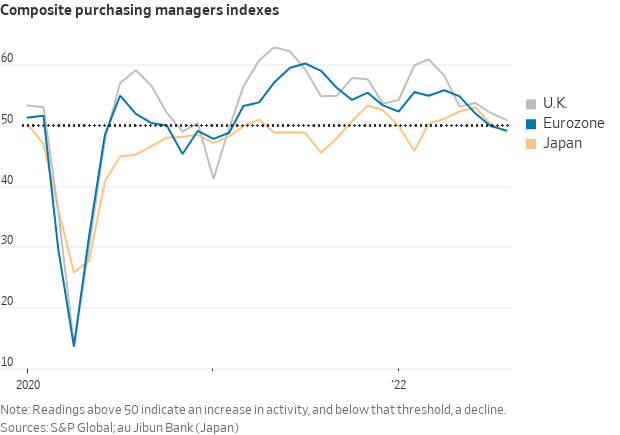
Growth in Japan’s manufacturing sector slowed to its lowest level since January 2021 as stuttering global demand, rising costs and the continuing effects of the covid-19 pandemic hit the country’s factories. Au Jibun Bank’s purchasing managers’ index, a key benchmark, fell from 52.1 in July to 51 in August, preliminary readings showed.
Market perspectives:
• Outside markets: The U.S. dollar index is weaker but hit a nearly 20-year high in early U.S. trading. The surging greenback is denting bullish enthusiasm in many raw commodity markets, as they are priced in U.S. dollars on the world market. The appreciating greenback is making those commodities more expensive to purchase in non-U.S. currency. The prospect of narrowing the disconnect sent the CBOE Volatility Index, Wall Street’s fear gauge, to its highest level for a month while the 10-year Treasury yield closed above 3% for the first time since June. The 2-year yield is even higher, a sign of looming recession. Crude has moved higher with U.S. crude around $91.90 per barrel and Brent around $97.80 per barrel. Gold and silver are mixed, with gold firmer around $1,750 per troy ounce and silver weaker around $18.86 per troy ounce.
• U.S. natural gas for September delivery topped $10 per million British thermal units early Tuesday, up more than 20% this month and more than twice the price a year ago. Prices haven’t been that high since 2008. The 14-year highs reached this week by U.S. natural-gas futures show the unceasing demand for U.S. shale gas across the Atlantic — and likely point to higher prices ahead, the Wall Street Journal reports (link). The latest price spike came in response to Russia’s plans to shut down one of Europe’s main fuel arteries for a few days at the end of the month. The shutdown announced Friday is either the latest episode of unplanned maintenance along the vital Nord Stream gas pipeline or an act of economic warfare on Russia’s part in retaliation for Western Europe’s support for Ukraine, the WSJ notes. Surging prices in Europe, weather that remains hotter than normal in much of the country and the heart of hurricane season, when storms can knock out production platforms in the Gulf of Mexico, threaten to send prices higher.
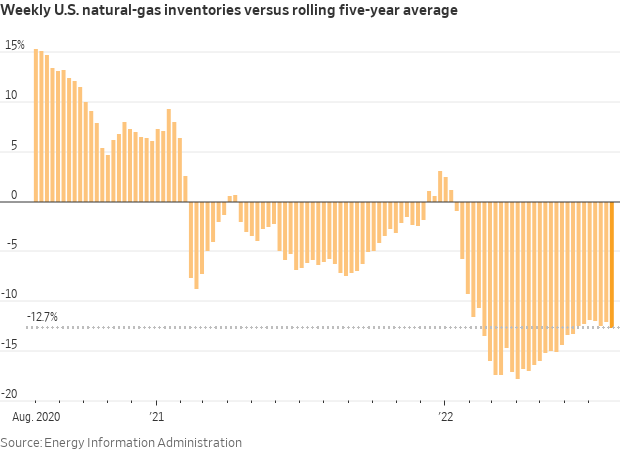
• OPEC+ could reverse action and tighten oil supply. Saudi Oil Minister Prince Abdulaziz bin Salman said "thin liquidity and extreme volatility" in the futures market are moving prices in ways that do not conform to normal supply and demand factors, which may spark OPEC+ to take action. The Saudi-led group could tighten production when it meets next month, doing a U-turn after reversing all of the cuts made during the Covid-19 pandemic. Crude oil futures have slumped 27% since mid-June amid concerns about the global economy, surging shipments from Russia and the possibility of more Iranian oil coming back online in the event of a nuclear deal. The WTI benchmark even recently fell under $90 per barrel, but pared losses following the Saudi prince's comments.
• Acres that U.S. farmers were unable to plant have more than tripled from the same period last year as extreme weather wreaks havoc on fields. Prevented planting acres were at 6.4 million, according to the USDA Farm Service Agency’s August report. That’s up from 2.1 million in 2021. Corn was the hardest hit with more than 3 million acres unplanted, with the data indicating there were 1.19 million corn acres in North Dakota and 540,193 corn acres in South Dakota prevented from planting. Soybean prevented planting totaled 987,229 acres in the August data, with more than half — 522,061 acres — in North Dakota.
• Day 1 Pro Farmer Crop Tour results for South Dakota and Ohio. Scouts on the first day of the Pro Farmer Crop Tour found an average corn yield of 118.45 bu. per acre in South Dakota, down sharply from both last year’s 151.45 bu. per acre estimate and the three-year Crop Tour average of 161.59 bu. per acre. Soybean pod counts in a 3’x3’ square came in at 871.40 for South Dakota, down from 996.86 in 2021 and 1,026.86 for the three year average.
In Ohio, samples yielded an average corn yield of 174.17 bu. per acre, down from 185.06 bu. per acre in 2021 but up from the three-year average of 169.03 bu. per acre. Soybean pod counts in a 3’x3’ square totaled 1,131.64 for Ohio, down from 1,195.37 in 2021 and below the three-year average of 1,038.35.
Agenda: Today, scouts on the eastern leg of the Tour will sample routes from Noblesville, Indiana to Bloomington, Illinois, and scouts on the western leg will sample southeast Nebraska and Iowa.
• NWS weather: Heavy Rain and Flash Flooding threats expected to slowly shift from southeastern Texas to the Lower Mississippi Valley over the next two days... ...Above average temperatures to continue from the inland valleys of California into the Great Basin and Pacific Northwest, while below average temperatures expected across the South from the Southern Plains into the Southeast.

Items in Pro Farmer's First Thing Today include:
• Corn, soybeans and wheat higher overnight
• Consultant holds U.S. corn and soybean yield forecasts unchanged
• Corn and soybean CCI ratings slip, spring wheat crop improves
|
RUSSIA/UKRAINE |
— Summary: Russia appears to be amassing missiles in Belarus in preparation for an attack on Ukraine, according to an independent military intelligence group. Meanwhile, Russia’s intelligence service on Monday blamed “Ukrainian special services” for carrying out a car bombing on Saturday which killed Darya Dugina, a 29-year-old journalist and the daughter of the prominent pro-Putin intellectual Alexander Dugin. Russia’s FSB also blamed Estonia for harboring the perpetrator of the attack, whom they suspected of being a Ukrainian national. Ukraine’s government has denied involvement.
- The U.S. gov’t urged its citizens to leave Ukraine, saying it believed Russia was preparing to target civilian and government infrastructure in the next few days as the war reaches the six-month mark on Wednesday. The warning followed a ban by the Ukrainian government on celebrations in the capital Kyiv on tomorrow's anniversary of independence from Soviet rule due to fears of attack.
- Discussions are ongoing to try to secure the release of Americans Brittney Griner and Paul Whelan from Russia, U.S. State Department spokesperson Ned Price said Monday, adding that officials are working "with the utmost urgency."
|
POLICY UPDATE |
— ERP payments at $6.47 billion as of Aug. 21. Payments under the USDA Emergency Relief Program (ERP) increased to $6.47 billion as of August 21, up from $6.37 billion the prior week. The total includes $5.61 billion to non-specialty crop producers ($5.51 billion prior) and $862 million to specialty crop producers ($824.1 million prior) for eligible 2020 and 2021 losses related to natural disasters.
USDA has mailed additional applications under Phase 1 which they said would be for over $750 million in payments before factors are applied.
Meanwhile, payments under the Coronavirus Food Assistance Program 1 (CFAP 1) edged up to $11.81 billion for total payments ($11.8 billion prior), including $10.62 billion in original CFAP 1 payments ($10.61 billion prior) while top-up payments remained steady at $4.83 billion. There were no changes in CFAP 2 payments as of August 21.
— USDA will spend $300 million to help farmers transition to organic production and on market development projects. It would be the single largest investment ever in organic agriculture by the USDA "and a big step in the right direction," said the Organic Trade Association. Link for details.
|
PERSONNEL |
— Fauci will step down in December. Anthony Fauci, the nation’s top infectious disease expert who led the federal government’s response to the Covid-19 pandemic across two presidential administrations, will step down at the end of this year. The 81-year-Fauci, who heads the National Institutes of Health’s National Institute of Allergy and Infectious Diseases said in a statement on Monday that he would leave his government post in December to “pursue the next chapter of my career.”
— Lorie Logan took the helm of the Federal Reserve Bank of Dallas on Monday, bringing the share of female central bankers in the US to nearly half and rounding out a year of change that has given the Fed its most diverse leadership team in history.
|
CHINA UPDATE |
— China’s currency has dropped to its weakest level against the U.S. dollar in two years and it is likely to depreciate further as the country’s central bank moves to combat a slowing economy and a deep housing downturn. On Tuesday, the yuan traded at more than 6.86 to the dollar in China’s tightly controlled onshore market, hitting levels last seen in August 2020, according to FactSet. The currency weakened past 6.88 in the more freely traded offshore market, taking its year-to-date decline against the dollar to more than 8%. Many analysts are expecting the yuan to weaken further. A weaker currency helps China’s exporters by making their goods cheaper. But it creates another headwind for foreign investors in stocks and bonds in mainland China by eroding their value. So far this year, international institutions have pulled more than $82 billion from yuan-denominated bonds, a record outflow for the asset class.
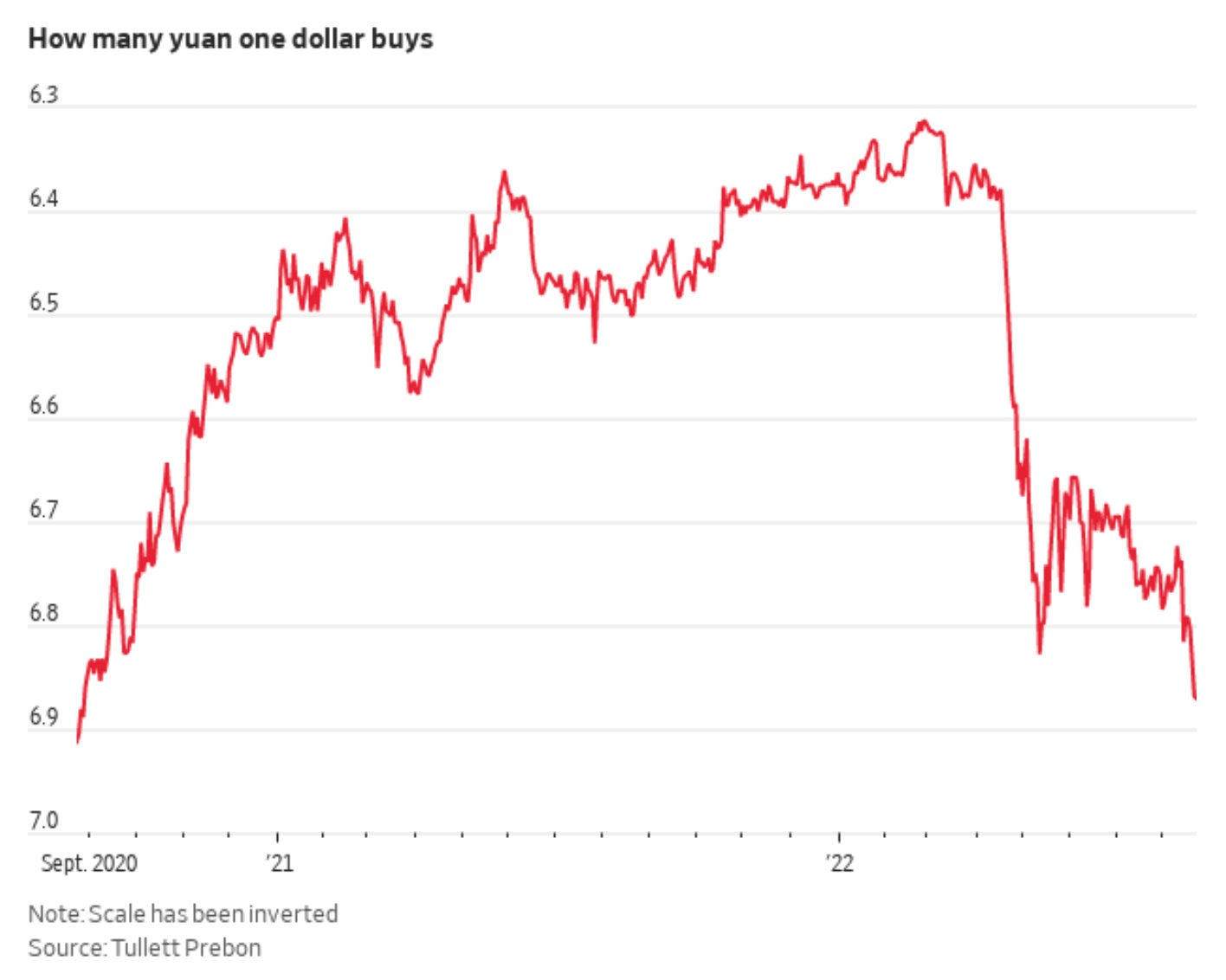
— Authorities in central China extended power curbs limiting factory production and opening hours for shopping malls, as the region grapples with its worst heat wave in six decades and a hydropower-depleting drought. The power rationing is undercutting industrial production, exacerbating the damage caused to China’s economy by the government’s stringent Covid-19 control measures
|
ENERGY & CLIMATE CHANGE |
— The Democrats’ climate law legally defines greenhouse gases as pollution. That will make new regulations harder to challenge in court. The new law amends the Clean Air Act to define the carbon dioxide produced by the burning of fossil fuels as an “air pollutant.” That language, according to legal experts, explicitly gives the EPA the authority to regulate greenhouse gases and to use its power to push the adoption of wind, solar and other renewable energy sources. When the Supreme Court restricted the ability of the Environmental Protection Agency to fight climate change this year, the reason it gave was that Congress had never granted the agency the broad authority to shift America away from burning fossil fuels. Link to details via the New York Times.
— NYT: Expansion of clean energy loans is ‘sleeping giant’ of climate bill. According to the New York Times (link): “Tucked into the Inflation Reduction Act that President Biden signed last week is a major expansion of federal loan programs that could help the fight against climate change by channeling more money to clean energy and converting plants that run on fossil fuels to nuclear or renewable energy. The law authorizes as much as $350 billion in additional federal loans and loan guarantees for energy and automotive projects and businesses. The money, which will be disbursed by the Energy Department, is in addition to the better-known provisions of the law that offer incentives for the likes of electric cars, solar panels, batteries and heat pumps. The aid could breathe life into futuristic technologies that banks might find too risky to lend to or into projects that are just short of the money they need to get going.”
— USDA opens application for renewable fuels infrastructure. USDA Secretary Tom Vilsack will be in Illinois to make an announcement on biofuel infrastructure spending with Sen. Tammy Duckworth (D-Ill.). Today, USDA has published a notice in the Federal Register (link) announcing the opening for those interested to submit applications under the Higher Blends Infrastructure Incentive Program (HBIIP) for up to $100 million in competitive grants to eligible entities for activities designed to “expand the sales and use of renewable fuels.” Cost-share grants of up to 50% of total eligible project costs (not more than $5 million) will be made available to “assist transportation fueling and fuel distribution facilities with converting to higher blend friendly status for ethanol (i.e., greater than 10% ethanol) and biodiesel (greater than 5% biodiesel) by sharing the costs related to the installation, and/or retrofitting, and/or otherwise upgrading of dispenser/pumps, related equipment, and infrastructure,” USDA said in the notice.
Applications will be accepted from today (August 23) through Nov. 21.
|
CORONAVIRUS UPDATE |
— Summary:
- Global Covid-19 cases at 596,803,097 with 6,455,212 deaths.
- U.S. case count is at 93,623,973 with 1,040,898 deaths.
- Johns Hopkins University Coronavirus Resource Center says there have been 607,588,353 doses administered, 223,684,995 have been fully vaccinated, or 67.89% of the U.S. population.
— Pfizer and BioNTech asked the FDA to authorize their updated, Omicron-specific Covid booster shot. If given the greenlight, it could be available this fall. Meanwhile, CDC Director Rochelle Walensky signed a decision memo that Novavax’s Covid-19 vaccine be used as another primary series option for adolescents ages 12 through 17.
— Japan may ease border restrictions. Japan is mulling lifting requirements that travelers have pre-departure Covid tests and is increasing the daily cap on the number of people allowed into the country. Japan currently requires a negative Covid test taken within 72 hours of departure. The country may also waive testing requirements for those that are fully vaccinated, the Nikkei reported, with Fuji News Network reporting the daily level of inbound travelers could be increased as soon as next month to 50,000 from 20,000.
|
POLITICS & ELECTIONS |
— Primaries take place in three more U.S. states today:
- In Florida, Democrats choose whether Rep. Charlie Crist or Agriculture Commissioner Nikki Fried will run against Governor Ron DeSantis in November. Val Demings, a former police chief in Orlando, is the only Democratic candidate who could mount a meaningful challenge to Marco Rubio, a Republican and the current senator, in November. Polls that show her leading against Rubio have encouraged national Democratic donors.
- In New York, long-serving Democratic reps Jerry Nadler and Carolyn Maloney go head to head in Manhattan's redrawn 12th district.
- In Oklahoma, Republicans vote on whether Markwayne Mullin or T.W. Shannon will get a chance to replace retiring GOP Sen. Jim Inhofe.
— Record ‘dark money’ donation bolsters conservatives’ midterm hopes. A low-profile Republican financier donated $1.6 billion to a new group run by Leonard Leo, the well-connected lawyer and activist who helped to reshape the American judicial system by getting conservatives appointed to the Supreme Court. The donation is the single largest ever given to a political advocacy group. The donor: Barre Seid, a 90-year-old executive who made his fortune as the chairman and CEO of the electrical device manufacturer Tripp Lite. The New York Times notes that what’s unusual about the transaction is that instead of giving cash, Seid donated stock. The recipient, Marble Freedom Trust, got 100% of the shares of Tripp Lite following the company’s sale to Eaton, an Irish conglomerate, for $1.65 billion. The NYT account concludes “the donation seems legal but appears designed so that Seid could avoid paying taxes.” In a statement, Leo cited some of the left’s biggest donors, saying: “It’s high time for the conservative movement to be among the ranks of George Soros, Hansjörg Wyss, Arabella Advisors and other left-wing philanthropists, going toe-to-toe in the fight to defend our constitution and its ideals.”
|
OTHER ITEMS OF NOTE |
— Iran nuclear deal progressing. Iran has dropped some of its main demands on resurrecting a deal to rein in Tehran's nuclear program, including its insistence that international inspectors close some probes of its atomic program, bringing the possibility of an agreement closer, a senior U.S. official told Reuters. "We think they have finally crossed the Rubicon and moved toward possibly getting back into the deal on terms that President Biden can accept," the official said. The U.S. is encouraged that Iran “appears to have dropped some of its non-starter demands,” the State Department’s spokesman said, as the Biden administration continues to review the European Union’s latest proposal to revive the deal curbing the Islamic Republic’s nuclear program.
— Former President Donald Trump asked a federal court to temporarily block the FBI from reviewing the materials it seized two weeks ago from his Florida home, until a special master can be appointed to oversee the review.
— NASA's historic Artemis I rocket is ready to launch to the moon and back. After a review was conducted on Monday, the Artemis team received the "go" to launch the rocket and Orion spacecraft on Monday. It will be NASA's first return to the moon in 50 years.






